Sodium in Grain Choices Is High
 We have noticed that many grain foods in the grocery store are very high in sodium. With MyPlate recommending at least 6 one-ounce servings of grains per day, we figure this is very important to be aware of.When looking for food choices, always be sure to compare mg of sodium to calories. This is a quick way to gauge sodium content for the calories provided. Most people consume at or under 2,000 calories per day which is about the cut off for normal people according to the Dietary Guidelines for Americans. Those with hypertension or prehypertension or at risk for hypertension need to keep the amount to 1,500 or less.Grain foods that can be very high in sodium per calorie:• Frozen waffles• Frozen pancakes• Bread• Rolls• Stuffing• Boxed rice mix• Boxed pasta mix• Canned pasta items• Breading• Baked items• Bakery mixes like bread• Many prepared cereals• Tortillas and wraps• CrackersIf an item is whole grain that does not mean it is low in sodium. Different brands can really vary in the sodium amount so it is always best to read the label in this food category. If an item has 5% or less of the daily value for fat and sodium it is a good choice.
We have noticed that many grain foods in the grocery store are very high in sodium. With MyPlate recommending at least 6 one-ounce servings of grains per day, we figure this is very important to be aware of.When looking for food choices, always be sure to compare mg of sodium to calories. This is a quick way to gauge sodium content for the calories provided. Most people consume at or under 2,000 calories per day which is about the cut off for normal people according to the Dietary Guidelines for Americans. Those with hypertension or prehypertension or at risk for hypertension need to keep the amount to 1,500 or less.Grain foods that can be very high in sodium per calorie:• Frozen waffles• Frozen pancakes• Bread• Rolls• Stuffing• Boxed rice mix• Boxed pasta mix• Canned pasta items• Breading• Baked items• Bakery mixes like bread• Many prepared cereals• Tortillas and wraps• CrackersIf an item is whole grain that does not mean it is low in sodium. Different brands can really vary in the sodium amount so it is always best to read the label in this food category. If an item has 5% or less of the daily value for fat and sodium it is a good choice.
| Low-sodium grain choices | Calories | Sodium(mg) | ||
| Brown rice, plain | 173 | 3 | ||
| Pasta, plain | 210 | 0 | ||
| Oatmeal, plain | 150 | 0 | ||
| Cream of wheat, plain | 120 | 0 | ||
| Shredded wheat | 102 | 2 | ||
| Barley | 162 | 5 | ||
| High sodium grain choices | ||||
| Stuffing mix | 130 | 490 | ||
| Flour tortillas or wraps | 100 | 350 | ||
| Bread | 130 | 300 | ||
| Rolls | 110 | 260 | ||
| Bagels | 320 | 520 | ||
| Frozen waffles | 190 | 370 | ||
| Corn flakes | 100 | 200 | ||
| Crackers | 120 | 180 |


